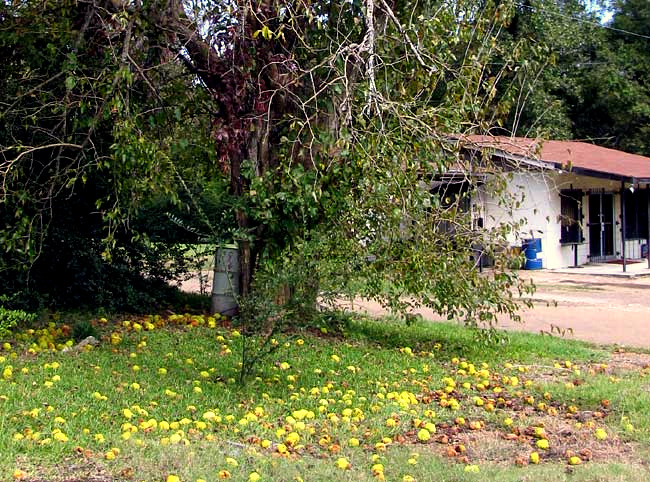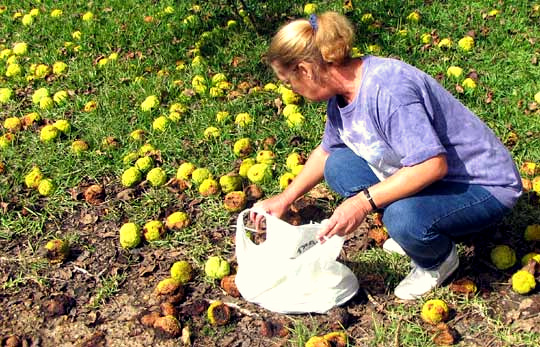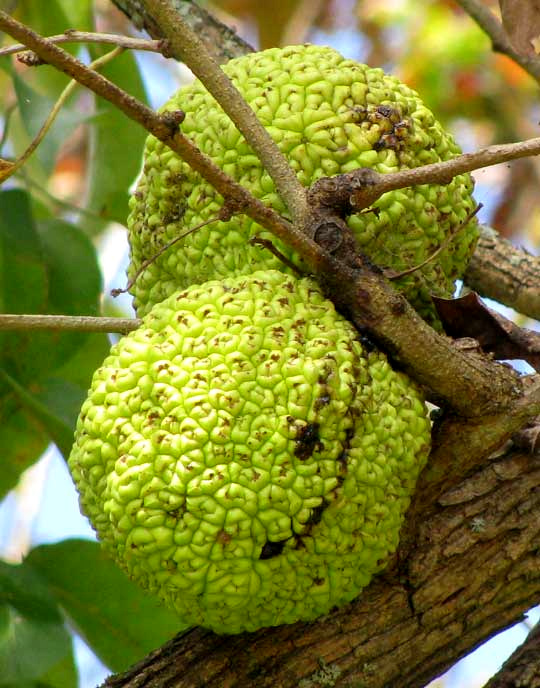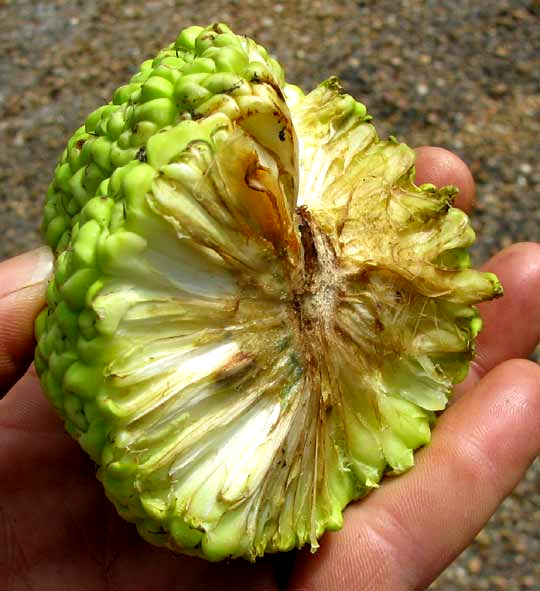Excerpts from Jim Conrad's
Naturalist Newsletter

from the the November 1, 2009 Newsletter, from near Natchez, Mississippi
OSAGE-ORANGES DROPPING
At a certain corner on the north side of Natchez you can see a tree doing the remarkable thing shown above. That's an Osage-orange tree, sometimes called Hedge Apple or Horse Apple. It's MACLURA POMIFERA a member of the Fig Family, the Moraceae. The yellowish things on the ground beneath the tree are large, heavy and hard fruits. Karen is seen collecting some for a future hedgerow below:

Below, you can see how Osage oranges hang on the tree.

That black stuff running down them is as gummy and sticky as you might expect from a member of the Fig Family. The fruits are multiple fruits, which means that what we think of as the fruit is actually many fruits fused together. Each bump on the multiple fruit's surface derives from a distinct small flower. A car tire had run over one "orange" knocking away its side. That was lucky for me because they're too hard and tough to break apart by hand. The cross section is shown below:

Osage-orange is native to a narrow slice of eastern Texas, southeastern Oklahoma, southwestern Arkansas, and the extreme northwest corner of Louisiana, which is a rather small area. However, it's been planted widely and has escaped, so now it grows in the wild across the US and in Ontario.
Osage-orange trees used to be much appreciated for their ability to form impenetrable, spiny hedges, for the twigs do bear short but stout and sharp spines. In fact, the Osage-orange was one of the main trees planted during Roosevelt's "Great Plains Shelterbelt" WPA project, launched in 1934 to prevent soil erosion in the Great Plains states. About 220 million Osage- oranges were planted during that program, which further explains why they show up in so many places today -- and why they deserve to be reconsidered for the service they once performed.
Though the fruits aren't edible for humans, once they've lain awhile they turn brown and mushy and sometimes squirrels tear them apart to get at the seeds. However, few other native animals make use of the fruit. That's unusual because most large, fleshy fruits have evolved to be eaten by large animals, which then disperse the seeds in their droppings. Some evolutionary biologists suggest that Osage-orange fruits once were eaten by large mammals that became extinct at the end of the last Ice Age -- Giant Ground Sloths, Mammoths, Mastodons, horses and others. Modern horses and other livestock do sometimes eat the fruits.
from the September 14, 2003 Newsletter, from near Natchez, Mississippi
OSAGE-ORANGE FRUITS
I wasn't sure how to manage the fruits to get seedlings next spring so I Googled up a Web site devoted entirely to Osage Orange, at http://www.hedgeapple.com.
At that site I learned how one old-timer had got his seeds to sprout. He'd dumped his fruits into a barrel and let them sit over the winter allowing them to freeze and thaw until spring, when they had grown soft. He'd kept the fruits moist during the winter, letting about two inches of water stand in the barrel's bottom. If fruits are kept submerged for an extended length of time, the seeds won't sprout. In the spring, he'd mashed the fruits, added water and poured the slurry into a plowed furrow, and covered it with an inch or two of soil. Then up came his hedgerow.
Lacking a barrel, I suspect that I'll just "stratify" the fruits -- bury them through the winter between layers of moist sand, and cover with leaves.
The www.hedgeapple.com site overflows with information about Osage Orange. I had known that American Indians once used its wood for making bows, and I'd seen cut slices of the fruits dried and used as Christmas decorations, but I hadn't known that when Lewis and Clark set off to explore the Louisiana Territory, the first tree they sent back East from St. Louis was the Osage- orange. The species is native to a relatively small area in eastern Oklahoma and portions of Missouri, Texas, and Arkansas, so it's been introduced wherever else it's found today, including here.
The Osage Orange's root bark produces a dye with colors ranging from tan to olive green, depending on the mordant. This dye was widely used during the First World War for dyeing khaki military uniforms.
Finally, I read with some skepticism that the crushed fruits may be useful for attracting and killing cockroaches.